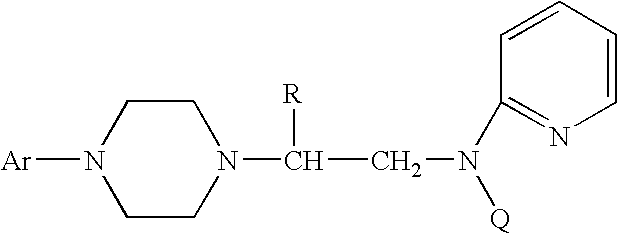Process for making chiral 1,4-disubstituted piperazines
a technology of chiral 1, which is applied in the field of process for making chiral 1, 4disubstituted piperazines, which can solve problems such as racemic amines
- Summary
- Abstract
- Description
- Claims
- Application Information
AI Technical Summary
Benefits of technology
Problems solved by technology
Method used
Image
Examples
example i
N,N-Bis(2-chloroethyl)-(R)-alanine Ethyl Ester, Trifluoromethanesulfonate
[0036]A suspension of bis(2-chloroethyl)amine hydrochloride (0.392 g; 2.1 mmol) in 5N aqueous sodium hydroxide (3 mL) is extracted with ether (2×10 mL) and the combined extracts are washed with a minimum amount of water and saturated brine. The ethereal solution is dried quickly over magnesium sulfate and filtered. Tetrahydrofuran (2 mL) is added to the filtrate, and ether is carefully removed under reduced pressure on a rotavapor unit without heating. The residue is mixed with a solution of ethyl (S)-2-[(methylsulfonyl)oxy]-propionate (0.5 g; 2 mmol) in tetrahydrofuran (1 mL). After stirring the reaction mixture for 24 hrs at room temperature, there is no visible precipitate. The volatiles are removed under reduced pressure and the remaining viscous oil is dissolved in ether (8 mL), and the slightly turbid solution is filtered after 60 minutes. The filtrate is treated dropwise with n-heptane to induce crystall...
example ii
(R)-4-(2,3-Dihydro-1,4-benzodioxin-5-yl)-α-methyl-1-piperazineacetic Acid Ethyl Ester
[0037]A solution of 2,3-dihydro-1,4-benzodioxin-5-amine (0.327 g; 2.16 mmol) in chlorobenzene (2 mL) is added to a solution of N,N-bis(2-chloroethyl)-(R)-alanine ethyl ester (trifluoromethanesulfonic acid salt; 0.850 g; 2.16 mmol) in the same solvent (2 mL). The stirred reaction mixture is heated at 130° C. for 15 hours, the volatiles are removed on a rotavap, and the semi-solid residue is partitioned between 10% sodium bicarbonate (15 mL) and ether. Organic extracts are washed with brine, dried over magnesium sulfate, and filtered. TLC (chloroform) shows formation of a new product with RF 0.15, (R)-4-(2,3-dihydro-1,4-benzodioxin-5-yl)-α-methyl-1-piperazineacetic acid ethyl ester. Upon addition of 1 N ethereal HCl, (R)-4-(2,3-dihydro-1,4-benzodioxin-5-yl)-α-methyl-1-piperazineacetic acid ethyl ester is converted into its hydrochloride salt that is collected by filtration; 0.615 g (80%), mp 168-171° ...
example iii
(R)-4-(2,3-Dihydro-1,4-benzodioxin-5-yl)-β-methyl-1-piperazineethanol
[0038]The hydrochloride salt made by Example II (1.07 g; 3 mmol) is suspended in 5% aqueous sodium bicarbonate (6 mL) and extracted with ether. The organic phase is separated, washed with brine, dried quickly over magnesium sulfate and filtered. The filtrate is added to a stirred suspension of lithium aluminum hydride (0.34 g; 9 eq) and the mixture is heated to a mild reflux for 3 hours. After cooling, it is decomposed with water (1 mL) and 0.5N hydrochloric acid (7 mL). The aqueous layer is separated, basified with 10% sodium bicarbonate and re-extracted with ether. The combined extracts are washed with small amounts of water and brine, dried over magnesium sulfate, filtered and evaporated. The oily product (0.69 g; yield 82%) slowly crystallizes upon standing, and can be recrystallized from n-butanol / n-heptane; mp 92° C.; enantiomeric purity 98%; 1H NMR (300 MHz, CDCl3) δ 1.03 (d, J=7 Hz, 3H), 2.74 (m,2H), 2.97 (...
PUM
| Property | Measurement | Unit |
|---|---|---|
| temperature | aaaaa | aaaaa |
| optically active | aaaaa | aaaaa |
| binding affinity | aaaaa | aaaaa |
Abstract
Description
Claims
Application Information
 Login to View More
Login to View More - R&D Engineer
- R&D Manager
- IP Professional
- Industry Leading Data Capabilities
- Powerful AI technology
- Patent DNA Extraction
Browse by: Latest US Patents, China's latest patents, Technical Efficacy Thesaurus, Application Domain, Technology Topic, Popular Technical Reports.
© 2024 PatSnap. All rights reserved.Legal|Privacy policy|Modern Slavery Act Transparency Statement|Sitemap|About US| Contact US: help@patsnap.com










